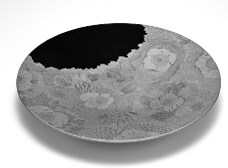Discussion
審査講評(4)
Comments on Gold Prize Winners

花を紡ぐ
Weaving Flowers
H5.5×W34×D34
2016

Deep Sea
H5.3×W65.3×D25.3
2017
Ohnishi ───── Thank you. We would like to continue with more comments from the panelists.
Next, the Gold Prize winner, a platter entitled ‘Weaving Flowers’ by Ms Sayo Kuroki, is displayed on your right. For this piece she applied Makie using tin powders to create a work of sensitivity and elegance, while the texture of the materials gives us quite a modern impression. It is certainly a refreshing work. I would like to ask Professor Nobuyuki Tanaka to make some comments.
Tanaka ───── This time we received more applications to the Art Category than Design. Furthermore, many works are sculptural in form. The Grand Prize winner has an abstract yet common shape. At first it appears to be a familiar piece of Urushi ware, but it is not. Upon opening the lid, we see the wooden body, from which we feel a sense of warmth and affection for life. All the jurors were in full agreement on our decision to make this work the Grand Prize winner.
The strongest competitor of the Grand Prize winner was the work by Ms Sayo Kuroki. At the Final Assessment the appraisals differed between the two works. So finally we democratically decided by a majority vote. Ms Kuroki’s work is with traditional Makie, mainly with the Hikkaki (scratching) technique yet she expresses a rather contemporary sensitivity. Whoever sees this work will immediately understand what I mean.
She performed detailed work which admits no mistakes. I really admire her excellent technique. I have observed her work since she began her training at the Kanazawa Utatsuyama Kogei Kobo and I have been favorably impressed by her remarkable progress. This work is surely one of her most important. All the jurors rated her work highly by valuing her way of showing her magnificent skills to best advantage.
Those who know the history of Urushi art understand the traditional image of Makie, and because of this, not many artists use Makie techniques for contemporary pieces. With the history behind Makie, it is hard not to try to emulate the treasures of Shosoin or Matsuda Gonroku. However, Ms Kuroki’s work represents something femininely expressive. Considering another female Urushi artist who has made similar works, Ms Hiromi Yamaguchi in Wajima comes to mind. Ms Kuroki’s expression is as excellent as Ms Yamaguchi’s, and I expect further great things from her.
To return to the piece itself, the lacquered part of the surface is matte, which creates a refined contrast, though I would have preferred the decoration to have been one millimeter further from the edge. The relation between the decorative expression and the shape should have been a little more deeply considered. Another point I am concerned about is the matte finish of the work. It is absolutely fine for display, however, considering this platter as an object for use, she could coat the surface thinly with Nashiji or Urushi.
Ohnishi ───── Thank you for your stimulating comments. Next, we would like Mr Shinichi Yamamura to comment on the Gold Prize winner in the Design Category, ‘Deep Sea’.
Shinichi Yamamura ───── Among the three main prize winners, this is the only work created by a male artist. This is a 65cm long rectangular platter chiseled out of chestnut wood. On close inspection it can be seen that the work is shaped solely through the use of chisels. His chiseling work is utilized in an excellent way through repetitions of 65cm chisel marks. The chestnut platter has an appropriate weightiness, not too heavy and not too light. The natural curves of the width and length gently opening out from the bottom add interest compared to the uniformity of mass-produced machine-made products. At first glance the shape is simple, but I feel the extraordinary power from the curves extending up the long side, the lovely curves streaming down from the inner rim, and the naturally created beautiful area at the four corners of the rectangular platter.
Its title is ‘Deep Sea’. Black Fuki Urushi or blue Urushi is applied as the finishing. It is completed skillfully to create a patina from the timing of the lacquer. This is how his chisel marks can be comfortably expressed. We hope that viewers will enjoy imagining what to arrange on the platter. Food, especially sushi would be particularly attractive. This platter makes us envision an enjoyable time with friends and family, an item which can be handed down from generation to generation. There is no superfluous decoration, just the sophisticated marks of his chisel coated with Urushi. It is an excellent work.
These three prize winners are all so excellent that it was quite difficult to make a value judgement among them. We discussed it extensively and intensively and finally decided which were to be the Grand Prize winner and the Gold Prize winners. Each of these three works is an unforgettable item. And for me, this work ‘Deep Sea’ is fabulous. When I held the work in my two hands, I could feel its warmth directly.
